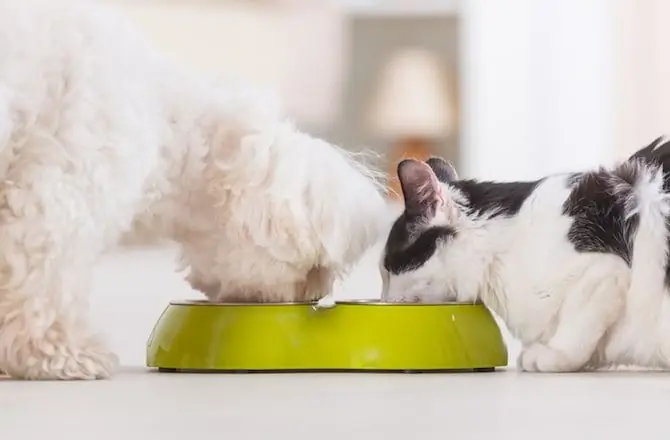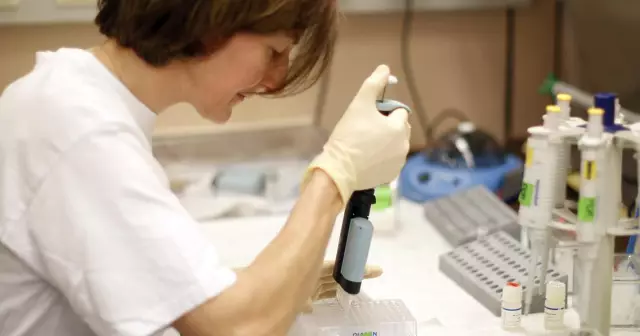
- Συγγραφέας Daisy Haig [email protected].
- Public 2023-12-17 03:07.
- Τελευταία τροποποίηση 2025-06-01 06:47.
Λοιπόν, τι είναι αυτό το ενοχλητικό τεστ κακά;
Είναι αρκετά αγχωτικό ώστε το πίσω μέρος του κατοικίδιου ζώου σας να παραβιάζεται από μια πλαστική ράβδο, σωστά; Λοιπόν, ποιο είναι το νόημα;
Λέτε: Εάν ο στόχος είναι να κάνω το κατοικίδιο ζώο μου πιο υγιές και χωρίς παράσιτα, θα εμπιστευτώ την κρίση σας, αλλά πρέπει να πω, οι έλεγχοι σκαμνιών είναι ένα είδος σκληρής και ασυνήθιστης τιμωρίας. Δεν έχω τέτοια ταπείνωση μέχρι να είμαι άντρας και σαράντα, σωστά; Και τα κόπρανα δεν είναι τόσο χρήσιμα, έτσι;
Λέω: Για αρχάριους, δεν χρειάζεται να υποκύψετε το κατοικίδιο ζώο σας στην τρομερή ράβδο. Ένα φρέσκο δείγμα λαμβάνεται συνήθως εύκολα το πρωί (ή το απόγευμα) πριν από την ετήσια επίσκεψή σας ή οποιαδήποτε στιγμή το κατοικίδιο ζώο σας πάσχει από γαστρεντερικά συμπτώματα. Δεν είναι τόσο δύσκολο, πραγματικά. Και εάν ο συγχρονισμός δεν είναι ακριβώς σωστός (το σκαμνί δεν πρέπει να είναι παλαιότερο από μία ώρα για καλύτερα αποτελέσματα), το νοσοκομείο του κτηνιάτρου σας σίγουρα δεν θα σας αρνηθεί το δικαίωμα να φέρετε ένα εξαιρετικά φρέσκο δείγμα στην ευκολία σας. Υπόσχεση.
Και ναι, οι εξετάσεις κοπράνων, αν και σχετικά φθηνές και ρουτίνες, είναι απαραίτητες. Όμως, όπως θα δείξει αυτή η ανάρτηση, είναι επίσης αλήθεια ότι όλες οι δοκιμασίες κοπράνων δεν θα μολύνουν παράσιτα στα κατοικίδια ζώα σας. Αυτός είναι ο λόγος για τον οποίο ενδέχεται να απαιτούνται ετήσιες και / ή σειριακές εξετάσεις κοπράνων.
Τώρα για τον πρωταρχικό στόχο του τεστ:
Οι κτηνίατροι παρακολουθούν πάντα τα παράσιτα που μπορεί να βρεθούν στο γαστρεντερικό σωλήνα των κατοικίδιων ζώων σας. Σίγουρα, εμείς οι άνθρωποι μπορούμε επίσης να πάρουμε παράσιτα, αλλά ο σύγχρονος τρόπος ζωής μας τείνει να είναι λιγότερο ευνοϊκός για τη μόλυνση των παρασίτων. (Πότε ήταν η τελευταία φορά που πήγαινε να χτυπάς στην αυλή, τα χείλη στο έδαφος, έτσι ώστε να μπορούσες να εισπνεύσεις ένα γατάκι γάτας ή δύο;)
Ναι, τα κατοικίδια έχουν πολλά παράσιτα. Ακολουθεί μια δειγματοληψία των πιο κοινών γαστρεντερικών παρασίτων που βλέπω εδώ [στον παράσιτο παράδεισο που είναι ημι-τροπική Νότια Φλόριντα]:
Σκουλήκια σε σκύλους και γάτες.
Άγκιστρα σε κατοικίδια
Σκουλήκια στα κατοικίδια
Giardia σε κατοικίδια

Ηπατικά σκουπίδια σε κατοικίδια
Ηπατικά σκουπίδια σε κατοικίδια
coccidia in pets
i’ll not go into the gory details on each but you can click on the links and check out the info for a better understanding of how these parasites can potentially affect your pets and even your human family.
sure, pet-popular parasites don’t often infect humans in the so-called, “developed” nations all of you reading this likely live in, but that doesn’t mean it doesn’t happen. roundworms and hookworms are still a factor in humans in the us, as is giardia, which will give you the nastiest case of diarrhea you can imagine short of amoebic dysentery.
since veterinarians are also on the front lines when it comes to public health, consider that fecal exams are not just necessary for healthy pets, they’re essential for healthy humans, too, more so if your family members are very young children, very old adults or otherwise immunocompromised (transplant patients, hiv-positive humans, chemo recipients, etc.).
how do we identify these critters in the fecal exam?
the short answer: with a microscope.
the long answer: we take a tiny sample of your pet’s stool (very fresh is always best). a few grams is enough (think an eighth of a teaspoon if that’s easier). then we put it through one of three processes.
1. the smear: we take about a half gram of stool and smear it onto a microscope slide to search for parasites (and bacteria) directly. many times we’ll see them swimming about. finding evidence of parasites in a simple smear is often indicative of severe infection.
2. the float: this method relies on mixing the stool with a special solution. it filters out the big pieces of stool in a tube or other cylindrical vessel and allows the eggs and other small critters to float up to the top, buoyed by the solution’s specific gravity. a microscope slide’s cover slip is typically used to recover the floaters. some parasites, however, aren’t amenable to flotation. eggs seem to do best through this method.
3. centrifugation: spinning the heck out of stool in a centrifuge when it’s mixed in a sugar solution picks up about 50% more parasite eggs and oocysts than through flotation. therefore, i like this method best for worm eggs, giardia, and coccidia--though i’d never go without a smear. problem is, most hospitals don’t yet use this method. it’s more expensive than others and research demonstrating it’s much greater efficacy is fairly recent.
so now you know the truth: not all fecal exams are created equal. not only does this test rely on careful selection of materials and methods, it also requires a trained eye. in our practice, for example, one of our techs detects parasites about 50% more often than the veterinarians and other techs/assistants. (that’s why we also do floats so that she can check them all at her convenience when she comes back from her day off.)
it’s also true that even a parasite-infected animal will often not come up positive on a fecal test. human error and equipment choice are factors, but so is the parasite itself. sometimes they do not make themselves known in the stool. worms sometimes aren’t shedding their eggs and subclinical (low-grade or smoldering) infections may not reveal much, either.
again, that’s why it’s important to perform this test as often as is reasonable. for all dogs and cats at least three times during the first few months of life. i want to see at least two negative tests in a row, a month apart, before i’ll feel comfortable that my patient is parasite-free.
for adults, once a year is great--that is, unless they show gastrointestinal illnesses. in this case, serial fecal tests make sense--or at least one every time the symptoms recur until a definitive diagnosis is made (whether it’s parasites or something else).
ultimately, fecal tests are a critical component of our veterinary hat of tricks. doing without may seem like the economically wisest thing in the absence of gastrointestinal symptoms, but consider: parasites can wear pets down in ways you might not expect. and it’s never wrong to be too safe in the presence of diseases that may also affect your family. ‘nuff said.
Συνιστάται:
Είναι ασφαλές το φαγητό του κατοικίδιου ζώου σας

Μια νέα μελέτη του Clean Label Project εξέτασε περισσότερες από 900 τροφές για σκύλους και γάτες και αντιμετωπίζει πάνω από 130 τοξίνες, όπως μόλυβδο και αρσενικό. Αυτό που βρήκαν ήταν το άνοιγμα των ματιών
Πίσω από τις σκηνές: Πώς είναι η επίσκεψη στον κτηνίατρο της διανυκτέρευσης του κατοικίδιου ζώου σας

Όταν το κατοικίδιο ζώο σας πρέπει να περάσει τη νύχτα στο νοσοκομείο ζώων, μπορεί να είναι δύσκολο τόσο για εσάς όσο και για το ζώο. Εδώ είναι τι μπορούν να περιμένουν οι ιδιοκτήτες από την ολονύκτια επίσκεψη στον κτηνίατρο του κατοικίδιου τους
Θα εμπιστευόσασταν την υγεία του κατοικίδιου ζώου σας στον Βοηθό του κτηνιάτρου σας

Θα εμπιστευόσασταν την υγεία του κατοικίδιου ζώου σας στον βοηθό του κτηνιάτρου σας; Η προσθήκη ενός «μεσαίου επιπέδου» επιπέδου κτηνιατρικής περίθαλψης, όπως και ο βοηθός ιατρού για την ιατρική, μπορεί να εξοικονομήσει χρόνο και χρήμα για τους καταναλωτές και να καταστήσει πιο δυνατή την κτηνιατρική περίθαλψη για τις ανεπαρκείς γεωγραφικές περιοχές. Διαβάστε περισσότερα
Η διάγνωση είναι καρκίνος, τώρα για τη θεραπεία - Θεραπεία του καρκίνου του κατοικίδιου ζώου σας

Την περασμένη εβδομάδα, ο Δρ Joanne Intile σας παρουσίασε στον Duffy, ένα παλαιότερο Golden Retriever, του οποίου η αδυναμία αποδείχθηκε ότι ήταν ένα σύμπτωμα οστεοσαρκώματος. Αυτή την εβδομάδα εξετάζει τις διάφορες εξετάσεις και θεραπείες για καρκίνο αυτού του τύπου
Ο φόβος είναι φίλος του κτηνιάτρου (οι φόβοι του κατοικίδιου ζώου σας, Redux)

Την περασμένη εβδομάδα δημοσίευσα σχετικά με το κόστος των spays και neuters στην κτηνιατρική πρακτική. Στα σχόλια κάτω από την ανάρτηση, κατέστη σαφές ότι η ανησυχία για τους κινδύνους που συνεπάγονται οι διαδικασίες, ιδίως για το ενδοκοιλιακό σπάσιμο, αυξάνεται μεταξύ σας. Ανεξάρτητα από το τι μπορούμε να πούμε εμείς οι κτηνίατροι για να ηρεμήσουμε τους φόβους σας, είναι αλήθεια. Κάθε χειρουργική επέμβαση έχει τους κινδύνους της. Και ενώ ένα spay είναι μια χειρουργική επ
